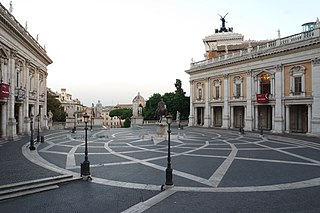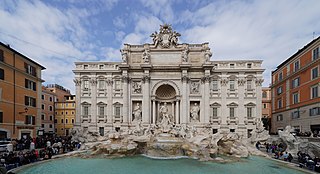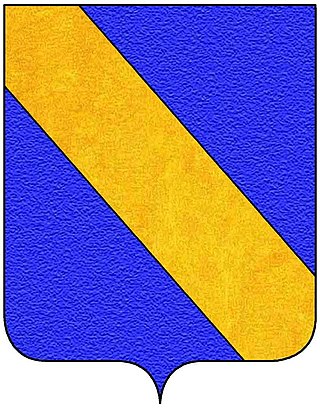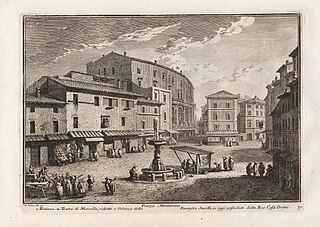History
The present aspect of the square is not the cozy one it had one time: one of the sides was destroyed during the demolitions for the building of the Vittoriano, begun in 1885, and later in the 1930s the whole area of the Capitoline Hill was isolated. The square was formerly called Market Square; it was divided into two part, the Mercato (Italian: Market), at the slopes of the Capitoline Hill, and the Mercatello (Italian: Little Market), at the opposite side northward. The two toponyms recurred in the dedication of two nearby churches: San Biagio del Mercato, later called Chiesa di Santa Rita da Cascia in Campitelli, still existing but relocated elsewhere, and San Giovanni in Mercatello, later Chiesa di San Venanzio, still remembered in the toponymy. In the surroundings of the square, probably where nowadays the Palazzo Muti Bussi and the Palazzo Astalli rise, two of the many towers of the town stood: the Torre del Mercato (Italian: Tower of the Market) and the Torre del Cancelliere (Italian: Tower of the Chancellor). The market served not just as a place for commerce, but as a stage for politic debates and religious homilies as well. In 1442 the words of St. Bernardino of Siena against gambling and usury resounded. In 1551 St. Ignatius of Loyola opened his first school of grammar and Christian doctrine, from which the Collegio Romano sourced, and held his first spiritual exercises. In 1713 Rosa Venerini opened the first Roman house of the Maestre Pie Venerini, the first women's public school in Italy. The buildings in the square include the Palazzo Muti-Bussi, the Palazzo Fani (now Pecci-Blunt ) and the Palazzo Massimo di Rignano, then Colonna, while the central feature is the fountain designed by Giacomo della Porta and realized in 1589 by Andrea Brasca, Pietro Gucci and Pace Naldini. The complicated demolitions Piazza d'Aracoeli has been subjected to, if on one hand have ruined the scenic design that Michelangelo used for the adjustment of the Capitoline Hill, on the other hand have opened a striking view on an outstanding urban landscape: from it is it possible to admire with a single glance the Quirinal Hill, the Trajan's Forum with its column and the Torre delle Milizie at the back, the two churches of Santa Maria di Loreto and of the Santissimo Nome di Maria, Palazzo Venezia and the buildings of the "Angelicum" cloister.

Girolamo Rainaldi was an Italian architect who worked mainly in a conservative Mannerist style, often with collaborating architects. He was a successful competitor of Bernini. His son, Carlo Rainaldi, became an even more notable, more fully Baroque architect.

Piazza del Campidoglio is a public square (piazza) on the top of the ancient Capitoline Hill, between the Roman Forum and the Campus Martius in Rome, Italy. The square includes three main buildings, the Palazzo Senatorio also known as the Comune di Roma Capitale, and the two palaces that make up the Capitoline Museums, the Palazzo dei Conservatori and the Palazzo Nuovo, considered to be one of the oldest national museums, founded in 1471 when Pope Sixtus IV donated some of the museum's most impressive statues, the She-wolf, the Spinario, the Camillus and the colossal head of emperor Constantine. Over the centuries the museums' collection has grown to include many of ancient Roman's finest artworks and artifacts. If something was considered too valuable or fragile in Rome and a copy was made in its place for display, the original is likely now on display in the Capitoline Museum.The hilltop square was designed by Michelangelo in the 16th century. at the behest of Pope Paul III.

Monti is the 1st rione of Rome, Italy, identified by the initials R. I, located in Municipio I. The name literally means 'mountains' in Italian and comes from the fact that the Esquiline, the Viminal Hills, and parts of the Quirinal and the Caelian Hills belonged to this rione: currently, however, the Esquiline Hill belongs to the rione Esquilino.

Trevi is the 2nd rione of Rome, Italy, identified by the initials R. II, located in Municipio I. The origin of its name is not clear, but the most accepted theory is that it comes from the Latin trivium, because there were three streets all leading to the current Piazza dei Crociferi, a square next to the modern Trevi square. Its coat of arms is made of three swords on a red background.

Campitelli is the 10th rione of Rome, Italy, identified by the initials R. X, and is located in the Municipio I.

Sant'Angelo is the 11th rione of Rome, Italy, located in Municipio I. Often written as rione XI - Sant'Angelo, it has a coat of arms with an angel on a red background, holding a palm branch in its left hand. In another version, the angel holds a sword in its right hand and a scale in its left.

Borgo is the 14th rione of Rome, Italy. It is identified by the initials R. XIV and is included within Municipio I.

Castro Pretorio is the 18th rione of Rome, Italy, identified by the initials R. XVIII, and it is located within the Municipio I. The rione takes its name by the ruins of the Castrum Praetorium, the barracks of the Praetorian Guard, included in the Aurelian Walls.

Campo Marzio is the 4th rione of Rome, Italy, identified by the initials R. IV. It belongs to the Municipio I and covers a smaller section of the area of the ancient Campus Martius. The logo of this rione is a silver crescent on a blue background.

Giacomo della Porta (1532–1602) was an Italian architect and sculptor, who worked on many important buildings in Rome, including St. Peter's Basilica. He was born at Porlezza, Lombardy and died in Rome.

The fountain in the Piazza d'Aracoeli is a fountain in Rome, Italy, located at the base of the Capitoline Hill, in the little square with the same name.

Santi Venanzio e Ansovino was a Roman Catholic church situated near the Capitoline Hill in Rome, in the area now occupied by the Piazza d'Aracoeli. It was dedicated to two saints associated with the city of Camerino: Venantius of Camerino, a martyr; and Ansovinus, bishop of Camerino. The church was also called SS Venanzio ed Ansovino de' Camerinesi.
George Francis Dillon was a 19th-century Catholic missionary and writer from Ireland. He became well known in 1884 for having given conferences in Edinburgh about what he claimed to be a Masonic war against Christian civilisation. His speeches were later compiled with his best-known book, War of Anti-Christ with the Church and Christian Civilization. After being read a summary of this work, Pope Leo XIII approved it and funded the publication of an Italian version.

Via dei Coronari is a street in the historic center of Rome. The road, flanked by buildings mostly erected in the 15th and the 16th century, belongs entirely to the rione Ponte and is one of the most picturesque roads of the old city, having maintained the character of an Italian Renaissance street.

The Capizucchi family was a noble Roman family. Considered one among the oldest families in Rome, it was deeply rooted in the Roman nobility because of the gallantry of many members. The family died out in the 17th century, and its name came to an end in 1813. The Capizucchis had their homes in Campitelli rione, at the foot of Capitoline Hill, and there also lay their palace. This still exists and is located between two squares, Piazza Campitelli and the one that took its name from the family, Piazza Capizucchi.

The Palazzo Maffei Marescotti or Palace of the Vicariate is a religious building in Rome, Italy.

The Albertoni Spinola Palace, with entrances in Campitelli square n. 2, Capizucchi square and vicolo Capizucchi is located in the 10th District. It was projected and executed by Giacomo Della Porta and Girolamo Rainaldi around the end of 16th century and the first years of 17th century.

Piazza Scossacavalli, also named Piazza di San Clemente, Piazza di Trento, Piazza d'Aragona, Piazza Salviati, was a square in Rome, Italy, important for historical and architectonic reasons. The square was demolished together with the surrounding quarter in 1937 due to the construction of Via della Conciliazione.

Piazza Montanara was an ancient and picturesque square of Rome (Italy) located at the foot of the Tarpeian Rock, in close proximity to the Capitolium and partially bounded by the Theatre of Marcellus.
Now it has completely disappeared following the demolition of the Fascist era, to create the initial stretch of Via del Mare, later called Via del Teatro di Marcello. The destruction of Piazza Montanara was part of a larger project of "isolation" of the Capitoline Hill, which ended up completely erasing the district of medieval origin that surrounded its east and south-east slopes.




















